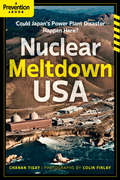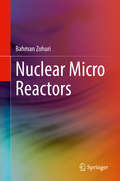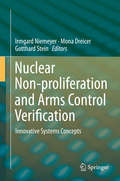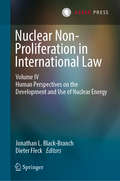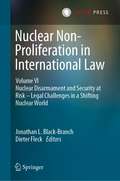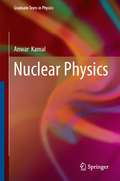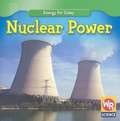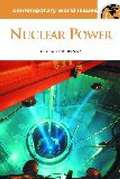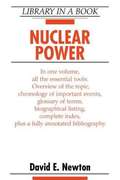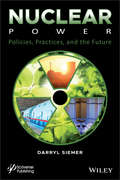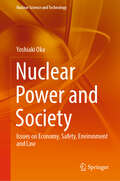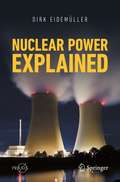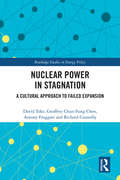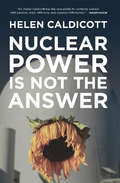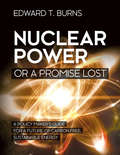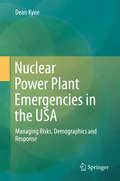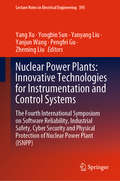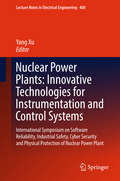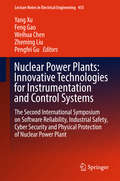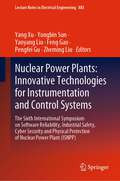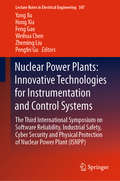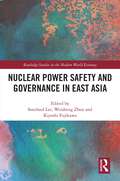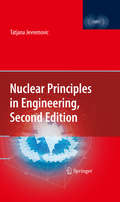- Table View
- List View
Nuclear Meltdown, USA: Could Japan's Power Plant Disaster Happen Here?
by Chanan TigaySitting near four significant fault lines on the coastline of California, Diablo Canyon is just one of 65 nuclear power plants in the United States. After the nuclear meltdown in Fukushima, Japan, Americans are now asking, "Could it happen here?" This e-book original, based on an in-depth investigation commissioned exclusively for Prevention magazine by the award-winning photojournalist team of Chanan Tigay and Colin Finlay, explores the risks--to our planet and ourselves--of the plant and its impact on the people who live and work in the "happiest place in America."
Nuclear Micro Reactors
by Bahman ZohuriThis book looks at Generation IV (GEN IV) nuclear reactor design and the technology known as nuclear micro reactors that is currently under development. Coverage includes the advantages of nuclear micro reactor applications as sources of renewable energy, their use in military applications and Department of Defense requirements, and the nuclear industry’s trend toward the design of small and micro reactors. Nuclear micro reactor safety, security issues, and cost concerns are also explored. The book will provide scientists, engineers, and students with valuable guidance on the fundamentals needed to understand the research and development of the next generation of nuclear technologies.
Nuclear Non-proliferation and Arms Control Verification: Innovative Systems Concepts
by Irmgard Niemeyer Mona Dreicer Gotthard SteinThis book strives to take stock of current achievements and existing challenges in nuclear verification, identify the available information and gaps that can act as drivers for exploring new approaches to verification strategies and technologies. With the practical application of the systems concept to nuclear disarmament scenarios and other, non-nuclear verification fields, it investigates, where greater transparency and confidence could be achieved in pursuit of new national or international nonproliferation and arms reduction efforts. A final discussion looks at how, in the absence of formal government-to-government negotiations, experts can take practical steps to advance the technical development of these concepts.
Nuclear Non-Proliferation in International Law - Volume IV: Human Perspectives On The Development And Use Of Nuclear Energy
by Jonathan L. Black-Branch Dieter FleckThis fourth volume in the book series on Nuclear Non-Proliferation in InternationalLaw focuses on human perspectives regarding the development and use of nuclearenergy; the need for regional solutions; and recent activities towards prohibiting andabolishing nuclear weapons.Jonathan L. Black-Branch is Dean of Law and Professor of International and ComparativeLaw; Bencher of the Law Society of Manitoba; JP and Barrister (England & Wales);Barrister & Solicitor (Manitoba); and, Chair of the International Law Association (ILA)Committee on Nuclear Weapons, Non- Proliferation & Contemporary International Law.Dieter Fleck is Former Director International Agreements & Policy, Federal Ministryof Defence, Germany; Member of the Advisory Board of the Amsterdam Center forInternational Law (ACIL); and Rapporteur of the International Law Association (ILA)Committee on Nuclear Weapons, Non- Proliferation & Contemporary International Law.
Nuclear Non-Proliferation in International Law - Volume VI: Nuclear Disarmament and Security at Risk – Legal Challenges in a Shifting Nuclear World
by Jonathan L. Black-Branch Dieter FleckThis sixth volume of the book series on Nuclear Non-Proliferation in International Law focuses on current legal challenges regarding nuclear disarmament and security. The Series on Nuclear Non-Proliferation in International Law provides scholarly research articles with critical commentaries on relevant treaty law, best practice and legal developments, thus offering an academic analysis and information on practical legal and diplomatic developments both globally and regionally. It sets a basis for further constructive discourse at both national and international levels. Jonathan L. Black-Branch is Chair of the ILA Committee on Nuclear Weapons, Non-Proliferation and Contemporary International Law and President and CEO of ISLAND - The Foundation for International Society of Law and Nuclear Disarmament. Dieter Fleck is Former Director International Agreements & Policy, Federal Ministry of Defence, Germany; Member of the Advisory Board of the Amsterdam Center for International Law (ACIL); Rapporteur of the International Law Association (ILA) Committee on Nuclear Weapons, Non-Proliferation & Contemporary International Law.
Nuclear Physics
by Anwar KamalThis textbook explains the experimental basics, effects and theory of nuclear physics. It supports learning and teaching with numerous worked examples, questions and problems with answers. Numerous tables and diagrams help to better understand the explanations. A better feeling to the subject of the book is given with sketches about the historical development of nuclear physics. The main topics of this book include the phenomena associated with passage of charged particles and radiation through matter which are related to nuclear resonance fluorescence and the Moessbauer effect. , Gamov's theory of alpha decay, Fermi theory of beta decay, electron capture and gamma decay. The discussion of general properties of nuclei covers nuclear sizes and nuclear force, nuclear spin, magnetic dipole moment and electric quadrupole moment. Nuclear instability against various modes of decay and Yukawa theory are explained. Nuclear models such as Fermi Gas Model, Shell Model, Liquid Drop Model, Collective Model and Optical Model are outlined to explain various experimental facts related to nuclear structure. Heavy ion reactions, including nuclear fusion, are explained. Nuclear fission and fusion power production is treated elaborately.
Nuclear Power
by Tea BenduhnSometimes big things come in tiny packages. Atoms are the smallest forms of matter, but they can release huge amounts of energy. Today, about 20 percent of our electricity comes from nuclear power. Learn we use nuclear power today and how scientists are working to make it a safer energy source for the future.
Nuclear Power: A Reference Handbook
by Harry HendersonProvides background information needed to understand nuclear power issues and guides readers toward accessible resources. Overviews developments in nuclear energy from the discovery of radiation to the present, then provides a chronology of events, biographical sketches of key figures, and tables, charts, and maps that explain how nuclear reactors work, how much energy they produce, where they are located, and plans for waste disposal. Reviews regulations, agencies, and court cases, provides statements from antinuclear groups, and lists government, academic, and industrial groups, and antinuclear groups. Also lists print and online resources, and includes a glossary of scientific and technical terms. Henderson is a science writer.
Nuclear Power
by David E. NewtonNuclear energy has sometimes been called the "double-edged sword of science", in reference to its ability to be used for both constructive and destructive ends. The first third of this book outlines the history of nuclear power production in the US and explores the issues that arise from its use, while the following sections provide extensive bibliographic references lists, tips for further research and excerpts from important laws and court decisions. It is targeted at policymakers, administrators, attorneys, advocacy groups, teachers, and students. Annotation ©2006 Book News, Inc., Portland, OR (booknews.com)
Nuclear Power: Policies, Practices, and the Future
by Darryl SiemerAs the world’s energy sources continue to develop, with less reliance on traditional fossil fuels and more reliance on cleaner, more efficient, alternative energy sources, nuclear power continues to be a dividing point for many people. Some believe it is the answer to our energy problems for the future, while others warn of the risks. Written by a retired scientist who spent most of his career at the Idaho National Laboratory (INL), this book aims to delve into the issues surrounding nuclear power and dispel its myths, while building an argument for why the United States should develop a nuclear power plan for the future. As a “whistleblower,” the author spent much of the last ten years of his career at the INL raising concerns about how its mission of serving as the Department of Energy’s lead laboratory in radioactive waste management was not being properly managed. While the United States continues to tread water on the issue of nuclear energy, the author believes that a nuclear “renaissance” is not only possible but is necessary for meeting the world’s growing demand for energy, especially clean energy. With fossil fuels slowly dying out and renewable energy sources not able to handle the demand for a continuously growing energy-consuming public, nuclear is an obvious solution. This book is a must-have for any engineer working in nuclear power, students hoping to go into that industry, and other engineers and scientists interested in the subject. This book is both “technical” and “political” because they’re equally important in determining what actually happens in institutions dealing with technical problems.
Nuclear Power and Society: Issues on Economy, Safety, Environment and Law (Nuclear Science and Technology)
by Yoshiaki OkaThis book offers a comprehensive description of the issues at the boundary between the use of nuclear power and society. Highlighting critical social topics such as economic liberalization, risk communication, radioactive waste, accountability, and non-proliferation, it provides an in-depth exploration of the multifaceted relationship between nuclear technology and societal impacts. The book covers a wide range of topics including the intersection of nuclear technology with economics, engineering, environmental studies, and law. Readers delve into the lessons learned from the TEPCO Fukushima accident, understand the complexities of risk communication, and explore the legal frameworks governing nuclear energy use. The highlighted issues at the interface between nuclear power utilization and society are meticulously organized, referring to historical information and insights from European and American government agencies and international organizations. This book is an essential read for graduate students, researchers, professors, engineers, government officials, and anyone interested in the social issues surrounding nuclear utilization. Written by an experienced professional who served as chairman of the Japan Atomic Energy Commission, it combines expert analysis with an engaging style to make complex topics accessible to a broad audience. The translation was done with the help of artificial intelligence. A subsequent human revision was done primarily in terms of content.
Nuclear Power Development: Prospects in the 1990s
by Stanley M. NealeyConsiders the prospects for a resumption in growth of nuclear power in the US over the next decade, examining its acceptability to five sectors in the US: the financial sector, the regulatory sector, the political sector, the knowledgeable "involved public", and the general "uninvolved public".
Nuclear Power Explained (Springer Praxis Books)
by Dirk EidemüllerFrom World War II to the present day, nuclear power has remained a controversial topic in the public eye. In the wake of ongoing debates about energy and the environment, policymakers and laypeople alike are once more asking the questions posed by countless others over the decades: What actually happens in a nuclear power plant? Can we truly trust nuclear energy to be safe and reliable? Where does all that radiation and waste go? This book explains everything you would want to know about nuclear power in a compelling and accessible way. Split into three parts, it walks readers through the basics of nuclear physics and radioactivity; the history of nuclear power usage, including the most important events and disasters; the science and engineering behind nuclear power plants; the politics and policies of various nations; and finally, the long-term societal impact of such technology, from uranium mining and proliferation to final disposal. Featured along the way are dozens of behind-the-scenes, full-color images of nuclear facilities. Written in a nontechnical style with minimal equations, this book will appeal to lay readers, policymakers and professionals looking to acquire a well-rounded view about this complex subject.
Nuclear Power in Stagnation: A Cultural Approach to Failed Expansion (Routledge Studies in Energy Policy)
by David Toke Geoffrey Chun-Fung Chen Antony Froggatt Richard ConnollyThis book studies the extent to which nuclear safety issues have contributed towards the stagnation of nuclear power development around the world, and accounts for differences in safety regulations in different countries. In order to understand why nuclear development has not met widespread expectations, this book focusses on six key countries with active nuclear power programmes: the USA, China, France, South Korea, the UK, and Russia. The authors integrate cultural theory and theory of regulation, and examine the links between pressures of cultural bias on regulatory outcomes and political pressures which have led to increased safety requirements and subsequent economic costs. They discover that although nuclear safety is an important upward driver of costs in the nuclear power industry, this is influenced by the inherent need to control potentially dangerous reactions rather than stricter nuclear safety standards. The findings reveal that differences in the strictness of nuclear safety regulations between different countries can be understood by understanding differences in cultural contexts and the changes in this over time. This book will be of great interest to students, scholars, and policymakers working on energy policy and regulation, environmental politics and policy, and environment and sustainability more generally.
Nuclear Power Is Not the Answer
by Helen CaldicottThe renowned antinuclear activist delivers a &“frighteningly convincing argument&” against nuclear energy as a solution to climate change (Publishers Weekly). In a world torn apart by wars over oil, politicians have stepped up their search for alternative energy sources—and their leading choice is nuclear energy. But nuclear energy&’s popularity as a green alternative is based on misinformation. People claim that nuclear-powered electricity does not cause global warming or pollution, that it is inexpensive, and that it is safe. These claims, as Helen Caldicott demonstrates, are untrue. In Nuclear Power Is Not the Answer, Caldicott digs beneath the nuclear industry&’s propaganda to examine the actual costs and environmental consequences of nuclear energy. In fact, nuclear power does contribute to global warming; the cost is prohibitive, with taxpayers picking up most of the tab; there&’s not enough uranium in the world to sustain it over the long term; and the potential for a catastrophic accident or a terrorist attack far outweighs any benefits. In concluding chapters, Caldicott details alternative sustainable energy sources that are the key to a clean, green future.
Nuclear Power or a Promise Lost: A Policy Maker's Guide for a Future of Carbon Free, Sustainable Energy
by Edward T. BurnsThis book captures the status of current electrical energy markets including the principal forces affecting decisions on selecting an energy source. It represents a seminal work that lays out the electrical energy decision tree for selecting an energy sou
Nuclear Power Plant Emergencies in the USA: Managing Risks, Demographics and Response
by Dean KyneManaging nuclear power emergencies is significantly different from managing other types of emergencies, including fire, flood, and other disasters because nuclear disaster management requires special technical skills and a rigid protocol which outlines detailed steps and procedure before an evacuation announcement could be made. It was evident that the impacts from a nuclear power core-meltdown accident were immerse, irreversible, and inevitable, as evident by evaluating the three historic core-meltdown accidents, namely Three Mile Island in 1997, Chernobyl in 1986, and Fukushima Daiichi in 2011. The three options for minimizing the risks associated with NPPs are suggesting elimination of all NPPs in operation in the United States, transforming inevitable risks to evitable risks, and transforming the current radiological plan into an effective emergency management plan. Being the latter option is the only viable one, this book provides a comprehensive understanding on effectively managing nuclear power emergencies in the U.S. The book presents detailed analysis on effectively managing nuclear power emergencies. In an attempt to illustrate minimizing the risks, factual answers to the key questions surrounding managing nuclear disasters are outlined. What are the risks associated with the nuclear power plants (NPP)? What are the problems associated with managing nuclear power core-meltdown accidents in the three historic accidents? Where are the geographical locations of the 99 commercial reactors in the U.S? Who are those exposed to potential risks associated with the NPPs? How could a projection of radioactive plume dispersion pathway be carried out using a spatial computer code, such as the Radiological Assessment Systems for Consequence Analysis (RASCAL) in case of a core-meltdown accident? Where would the radioactive plume go given weather conditions? Who are more likely to be exposed to the high level radiation dose during the core-meltdown accident? What are the issues with the current radiological emergency plan?
Nuclear Power Plants: The Fourth International Symposium on Software Reliability, Industrial Safety, Cyber Security and Physical Protection of Nuclear Power Plant (ISNPP) (Lecture Notes in Electrical Engineering #595)
by Yanjun Wang Yang Xu Zheming Liu Pengfei Gu Yongbin Sun Yanyang LiuThis book presents a compilation of selected papers from the Fourth International Symposium on Software Reliability, Industrial Safety, Cyber Security and Physical Protection of Nuclear Power Plant, held in August 2019 in Guiyang, China. The purpose of the symposium was to discuss inspection, testing, certification and research concerning the software and hardware of instrument and control (I&C) systems used at nuclear power plants (NPP), such as sensors, actuators and control systems. The event provides a venue for exchange among experts, scholars and nuclear power practitioners, as well as a platform for the combination of teaching and research at universities and enterprises to promote the safe development of nuclear power plants. Readers will find a wealth of valuable insights into achieving safer and more efficient instrumentation and control systems.
Nuclear Power Plants: Innovative Technologies for Instrumentation and Control Systems
by Yang XuThese proceedings present the latest information on software reliability, industrial safety, cyber security, physical protection, testing and verification for nuclear power plants. The papers were selected from more than 80 submissions and presented at the First International Symposium on Software Reliability, Industrial Safety, Cyber Security and Physical Protection for Nuclear Power Plants, held in Yinchuan, China on May 30 - June 1, 2016. The primary aim of this symposium was to provide a platform to facilitate the discussion for comprehension, application and management of digital instrumentation, control systems and technologies in nuclear power plants. The book reflects not only the state of the art and latest trends in nuclear instrumentation and control system technologies, but also China's increasing influence in this area. It is a valuable resource for both practitioners and academics working in the field of nuclear instrumentation, control systems and other safety-critical systems, as well as nuclear power plant managers, public officials and regulatory authorities.
Nuclear Power Plants: Innovative Technologies for Instrumentation and Control Systems
by Yang Xu Feng Gao Weihua Chen Zheming Liu Pengfei GuThese proceedings present the latest information on software reliability, industrial safety, cyber security, physical protection, testing and verification for nuclear power plants. The papers were selected from more than 80 submissions and presented at the First International Symposium on Software Reliability, Industrial Safety, Cyber Security and Physical Protection for Nuclear Power Plants, held in Yinchuan, China on May 30 - June 1, 2016. The primary aim of this symposium was to provide a platform to facilitate the discussion for comprehension, application and management of digital instrumentation, control systems and technologies in nuclear power plants. The book reflects not only the state of the art and latest trends in nuclear instrumentation and control system technologies, but also China's increasing influence in this area. It is a valuable resource for both practitioners and academics working in the field of nuclear instrumentation, control systems and other safety-critical systems, as well as nuclear power plant managers, public officials and regulatory authorities.
Nuclear Power Plants: The Fifth International Symposium on Software Reliability, Industrial Safety, Cyber Security and Physical Protection of Nuclear Power Plant (ISNPP) (Lecture Notes in Electrical Engineering #779)
by Yang Xu Yongbin Sun Yanyang Liu Feng Gao Pengfei Gu Zheming LiuThis book is a compilation of selected papers from the fifth International Symposium on Software Reliability, Industrial Safety, Cyber Security and Physical Protection of Nuclear Power Plant, held in November 2020 in Beijing, China. The purpose of this symposium is to discuss Inspection, test, certification and research for the software and hardware of Instrument and Control (I&C) systems in nuclear power plants (NPP), such as sensors, actuators and control system. It aims to provide a platform of technical exchange and experience sharing for those broad masses of experts and scholars and nuclear power practitioners, and for the combination of production, teaching and research in universities and enterprises to promote the safe development of nuclear power plant. Readers will find a wealth of valuable insights into achieving safer and more efficient instrumentation and control systems.
Nuclear Power Plants: The Sixth International Symposium on Software Reliability, Industrial Safety, Cyber Security and Physical Protection of Nuclear Power Plant (ISNPP) (Lecture Notes in Electrical Engineering #883)
by Yang Xu Yongbin Sun Yanyang Liu Feng Gao Pengfei Gu Zheming LiuThis book is a compilation of selected papers from the Sixth International Symposium on Software Reliability, Industrial Safety, Cyber Security and Physical Protection of Nuclear Power Plant, held in October 2021 in Zhuji, Zhejiang, China. The purpose of this symposium is to discuss Inspection, test, certification and research for the software and hardware of Instrument and Control (I&C) systems in nuclear power plants (NPP), such as sensors, actuators and control system. It aims to provide a platform of technical exchange and experience sharing for those broad masses of experts and scholars and nuclear power practitioners, and for the combination of production, teaching and research in universities and enterprises to promote the safe development of nuclear power plant. Readers will find a wealth of valuable insights into achieving safer and more efficient instrumentation and control systems.
Nuclear Power Plants: The Third International Symposium on Software Reliability, Industrial Safety, Cyber Security and Physical Protection of Nuclear Power Plant (ISNPP) (Lecture Notes in Electrical Engineering #507)
by Yang Xu Hong Xia Feng Gao Weihua Chen Zheming Liu Pengfei GuThis book is a compilation of selected papers from the 3rd International Symposium on Software Reliability, Industrial Safety, Cyber Security and Physical Protection of Nuclear Power Plants, held in Harbin, China on 15th–17th August 2018. The symposium discussed the status quo, technical advances and development direction of digital instrument control technology, software reliability, information security and physical protection in the process of nuclear power development. Offering technical insights and know from leading experts, this book is a valuable resource for both practitioners and academics working in the field of nuclear instrumentation, control systems and other safety-critical systems, as well as nuclear power plant managers, public officials, and regulatory authorities.
Nuclear Power Safety and Governance in East Asia (Routledge Studies in the Modern World Economy)
by Soocheol Lee Weisheng Zhou Kiyoshi FujikawaConfronting the challenges of nuclear power governance, this book provides pathways to nuclear safety cooperation between countries in East Asia where regional cooperation is challenged by geopolitical tensions. The book is split into three parts: first looking at nuclear risk and safety communications, second on nuclear policy and harmonization of safety standards, and third a comparative analysis of nuclear regulatory agencies in East Asia. Taken as a whole, the contributors recommend the establishment of a nuclear safety system that, which allows for mutual verification of safety standards at the regional level, and a regulatory framework with international credibility, which will help standardize risk communication. They suggest that the exchange of experiences involving nuclear power plant safety, efforts toward common safety standards, safety management, and collaborative efforts between Japan, China, and South Korea are extremely urgent issues. By comparing the European system of nuclear governance with that of East Asia, the book highlights the need for nuclear safety organizations in East Asia to strengthen interconnections and build regional linkages. This book will be of interest to policymakers, academics, and researchers in the field of energy policy, energy economics, nuclear safety, nuclear governance, and nuclear engineering.
Nuclear Principles in Engineering
by Tatjana JevremovicNuclear engineering plays an important role in various industrial, health care, and energy processes. Modern physics has generated its fundamental principles. A growing number of students and practicing engineers need updated material to access the technical language and content of nuclear principles. "Nuclear Principles in Engineering, Second Edition" is written for students, engineers, physicians and scientists who need up-to-date information in basic nuclear concepts and calculation methods using numerous examples and illustrative computer application areas. This new edition features a modern graphical interpretation of the phenomena described in the book fused with the results from research and new applications of nuclear engineering, including but not limited to nuclear engineering, power engineering, homeland security, health physics, radiation treatment and imaging, radiation shielding systems, aerospace and propulsion engineering, and power production propulsion.
